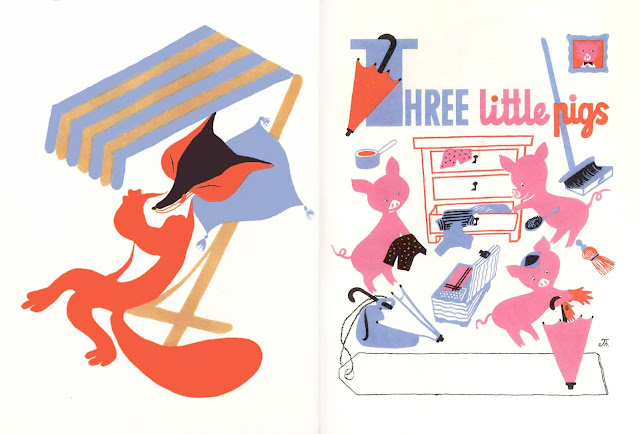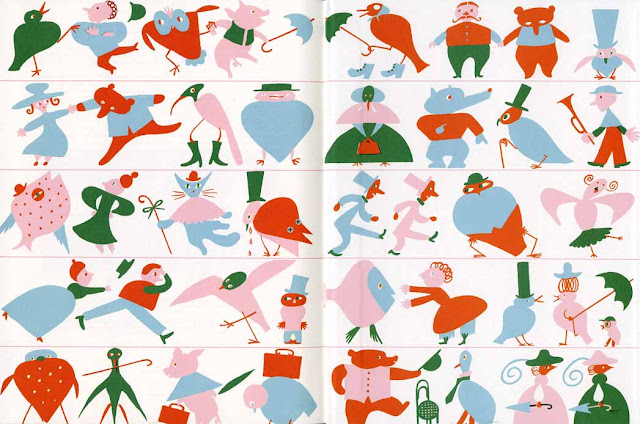Monday, January 31, 2011
Sunday, January 30, 2011
Sunday Safari - Goodbye Tiger
1960's wooden Tiger wall plaque, originally from a French Circus, at Fears and Kahn
We are approaching the end of The Year of the Tiger
and I wanted to salute these majestic, wonderful creatures
who unfortunately are constantly under threat of extinction.
Long live the Tiger!
André Hellé, Grosses bêtes and petites bêtes, 1912,
thanks to the always wonderful A Journey Round My Skull
Sergio Ruffolo, Tigre homemade greeting card
Meg Hunt for the Cloudy Collection
Celestino Piatti, illustration for Der goldene Apfel: Eine Geschichte, 1970
found thanks to a lovely post about tigers on Booktryst
Cathie Bleck, Tiger
Ian McArthur, Tiger
Jan Młodożeniec, Tygrysek, 1961
Sebastiano Ranchetti, Little Tiger
Dale Maxey, illustration from The Wild and woolly animal book, 1966,
thanks to Bonito Club
Pierre Bevès, Le tigre en bois, 1961, thanks to maptitefabrique
Antonio Ligabue, Tigre con ragno, 1953
Saturday, January 29, 2011
Avant-Garde in the Nursery
Polish avant-garde artist Franciszka Themerson (1907-1988) illustrated the delightful
My First Nursery Book in 1947. Franciszka was a woman of many talents, whose
endeavours included painting, illustration, graphic design, stage design,
art direction, publishing, film-making and marionette theatre.
In many of these projects she was accompanied by her husband, the writer,
Visit the Themerson Archive to appreciate the many collaborative
efforts of this wonderfully creative couple.
My First Nursery Book includes four classic tales: Who Killed Cock Robin?,
The Gingerbread Man, Three Little Pigs and The Three Bears.
It was republished by Tate in 2009.
The cover and endpapers scans come from a guest post on Curious Pages,
in which illustrator Carson Ellis presented some of the spreads from the book.
Thursday, January 27, 2011
Matazo Kayama
Matazo Kayama (1927-2004) was born in Kyoto, the son of a designer of Kimono.
He used to play in his father's studio, and loved to see him and his disciples
at work sketching and painting. He also learned a lot from his father's collection
of international art books. Kayama started making art, and when he was 13 years old
he entered the Japanese Painting Academy in Kyoto. In 1944 he went on to study
when the country was in the grips of World War II. His father died at the end
of the war, but Kayama managed to keep studying art in Tokyo
while helping his mother and younger sisters in Kyoto.
A Thousand Cranes, 1970, a pair of six-fold silk screens, 1.6 x 3.7m each
(click on the image to enlarge)
Kayama became a famous painter in his early 30's and held his first personal exhibition
abroad in New York in 1961. Animals were one of his favorite themes throughout his career,
while his sources of inspiration shifted from modern Western art to traditional RImpa Japanese
painting and Chinese ink paintings. All of these influences were reinterpreted through Kayama's
painting and Chinese ink paintings. All of these influences were reinterpreted through Kayama's
own refined and innovative style. His work has been exhibited at the Central Museum of Beijing
and the British Museum, and in 2009 a large retrospective was held at Tokyo's National Art Center.
thanks to Sandi Vincent for this image
Tuesday, January 25, 2011
The Tree and the Cat
Another lovely and melancholy Russian animation from Niffiwan's
fantastic You Tube channel Animatsiya in English.
Directed by Yevgeny Sivokon at Kievnauchfilm in 1983.
Directed by Yevgeny Sivokon at Kievnauchfilm in 1983.
Monday, January 24, 2011
Sunday, January 23, 2011
Sunday Safari – Prickly & Sweet
Chen Yu Ping, Fruits in Frost, print from Heilongjiang
thanks to A Journey Round My Skull
Miumau (?)
Sabater Pi, 1964, thanks to a beautiful recent post on BibliOdyssey
Yuri Vasnetsov, Ruff kids
Patricia Mullins, All in together, 1974, thanks to flamenconut
Subscribe to:
Posts (Atom)























































